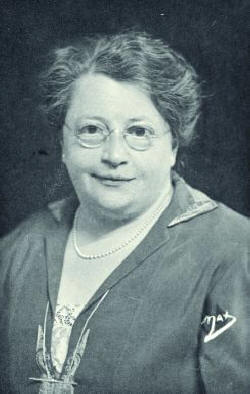

Queer Places:
Amsterdam Begraafplaats Zorgvlied
Amsterdam, Amsterdam Municipality, Noord-Holland, Netherlands
 Rosette
Susanna "Rosa" Manus (20 August 1881 – 1942) was a Dutch
pacifist and
female suffragist.
Rosette
Susanna "Rosa" Manus (20 August 1881 – 1942) was a Dutch
pacifist and
female suffragist.
Rosa Manus was born the second of seven children to affluent Jewish parents, Henry Philip Manus, a tobacco merchant, and Soete Vita Israël, a homemaker, in Amsterdam in the Netherlands.[1][2]
Manus became involved with the international women's suffrage movement in 1908 at the Congress of the International Woman Suffrage Alliance (IWSA). At the 1908 Congress she met Dutch suffragist Aletta Jacobs and American suffragist Carrie Chapman Catt, who would become lifelong colleagues and friends. Catt and Manus in particular developed a close relationship.[3]
Following the 1908 Congress, Manus became secretary of the Dutch Association for Women's Suffrage.[2] In 1913, Manus served as organizer, together with Mia Boissevain, of the exhibition "De Vrouw 1813–1913," on the lives of Dutch women.[4]
In 1915, Manus played a large role in organizing the International Congress of Women in The Hague. Following this, she was appointed secretary of the International Committee of Women for Permanent Peace, later known as the Women's International League for Peace and Freedom (WILPF).
Manus accompanied Carrie Chapman Catt, then President of the International Woman Suffrage Alliance, on a world tour in 1922-1923.
In 1926 Manus was appointed Vice-President of the International Woman Suffrage Alliance, which she was to remain until her death in 1942.
In 1913 Clara Meijers heard about the women’s bank in Berlin and tried to establish one in the Netherlands since then. In 1928, Clara Meijers became the first female bank director and was responsible for the Women’s Bank of the Rotterdamsche Bankvereeninging, a branch of the Rotterdamsche Bank, Amsterdam. This office was set up especially for female clients. Rosa Manus was its first customer.
In 1932 Manus was appointed Secretary of the International Women’s Organizations’ International Disarmament Committee. She presented more than eight million signatures from fifty-nine countries to the League of Nations’ Chairman during the disarmament conference in Geneva. Still more signatures were received after the petition’s presentation that ultimately came to a total of more than ten million. Rosa Manus founded the Dutch Women’s Electricity Association on 7 September 1932.
In 1935 she journeyed to Egypt with Margery Corbett Ashby (Catt’s successor as International Alliance President), Germaine Malaterre-Sellier and Christine Bakker-van Bosse. Manus and Corbett Ashby then travelled to Palestine, while the other two went on to Lebanon and Syria. The objective here was to encourage women to attend the 1935 conference in Istanbul, which was to be the Alliance’s first international conference in a non-western country.
In 1935, together with Johanna Naber and Willemijn Posthumus-van der Goot she established the International Archives for the Women's Movement (IAV), later known as the International Information Centre and Archives for the Women's Movement and currently known as Atria Institute on gender equality and women's history.[4] Among the books Rosa Manus donated to the IAV were also books of Aletta Jacobs she received in 1930.The IAV were closed by the Nazis on 2 July 1940 and ransacked ten days later.
Manus was made an Officer of the Order of Orange-Nassau by royal decree on August 22, 1936[5].
Manus was arrested by the Gestapo for being state dangerous on 16 August 1941.[6] She spent three weeks in prison in Scheveningen. She was sent to Dusseldorf in September 1941. She was imprisoned at the police headquarters, where the Gestapo also had its own interrogation facilities. She was transferred to Ravensbrück concentration camp on 2 October 1941. Arrived on or around 25 October 1941.[7] She was likely gassed at Bernburg in March 1942, but there is conflicting information around her date of death.[4] On 23 July 1942, the family received a message from Ravensbrück that Rosa Manus had died on 29 May 1942. After the war, the Red Cross recorded 28 April 1943 as her date of death. For a long time, this was regarded as being the most likely date, as the Nazis’ announcements of deaths often turned out to be intentionally false. However, Myriam Everard’s research has since revealed that 28 April 1943 is also wrong.
A memorial plaque at Amsterdam Begraafplaats Zorgvlied at her family tomb, reads: "Born in Amsterdam in 1881, died and buried at the German concentration camp in Ravensbrück in 1943, used her organisational talent and knowledge of human nature, her energy and ability TO HELP THE ADVANCEMENT OF WOMEN. Few have surpassed Rosa Manus in dedication and selflessness."
My published books: